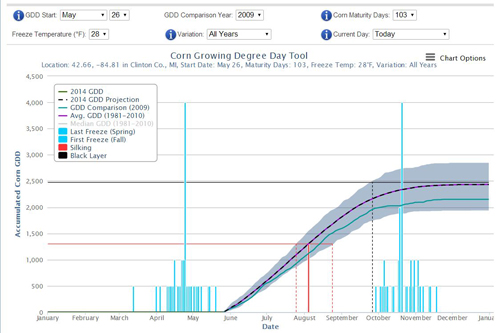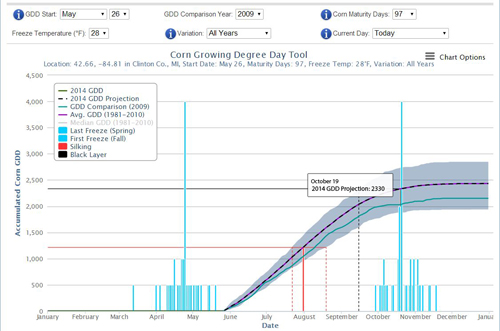Planting corn past Memorial Day – what are the risks?
The second full week of May was a wet one! Just as fields were getting dry enough to plant, another round of rain came, pushing planting back again. This has left many farmers wondering how the late planting date will impact fall harvest.
Historical weather data has been collected and compiled for years, but it has not always been the easiest to apply to local questions. However, a web-based decision tool was recently developed that allows farmers to quickly compare current conditions to a 30-year historical perspective. Should your cropping strategy change, this tool makes it easy to project potential outcomes based on historical climate data. With the U2U Decision Support Tool – Corn GDD, users can change planting date and hybrid maturity to get an indication of what to expect this fall based on observed conditions during the past 30 years.
Given the recent rains, corn planting was delayed on many Michigan farms. Using the U2U Decision Support Tool for Clinton County with corn emerging Memorial Day, May 26, we will compare the likelihood for corn reaching black layer before the first killing frost of 28 degrees Fahrenheit. The example in Photo 1 looks at 103-day corn and the example in Photo 2 compares 97-day corn.

Photo 1. Outlook for 103-day corn based on 30-year historical weather data.
Planting a 103-day variety will take 2,473 growing degree days (GDD) to reach black layer. If the corn is planted May 26, it will only have accumulated an average of 2,353 GDD, based on the past 30 years, prior to the average first killing freeze of the fall, which was Oct. 25 in this area. If the killing frost is as early as it was in 1991, which was Sept. 28, the corn will have low test weight and drying bills will be high. However, if we have a long growing season and the first killing freeze is Nov. 23, like 2007, the corn has a better chance of reaching black layer, especially if we have warmer than normal temperatures and above average GDDs.

Photo 2. Outlook for 97-day corn based on 30-year historical weather data.
Changing to a 97-day corn hybrid will increase the likelihood of the corn reaching black layer before the first killing frost. This hybrid is projected to take 2330 GDD to reach black layer and on average will occur October 18. While there is still risk involved, the odds are relatively better that the corn will mature.
Michigan State University Extension encourages producers to take this decision tool for a test drive. Using the U2U Corn GDD tool, growers can run any number of scenarios to answer questions unique to their situation. Changing the inputs of planting date and corn maturity days are easy. While we realize no one can predict the future, we can look at history to determine probable risk, obtain some idea of the variability and range of outcomes, and make decisions that we can live with.
The Corn GDD support tool was developed by Useful to Useable (U2U), a team made up of faculty, staff and students from nine Midwestern universities working to develop decision support tools and resources to support resilient and profitable crop production. U2U is funded by a grant from USDA.
Additional information
- MSU Extension’s Cool, Wet Spring and Delayed Planting



 Print
Print Email
Email




